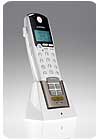
PHOTO COURTESY OF INGRID
On January 8, InGrid was officially introduced into the marketplace. InGrid is a digital home protection security system for the residential and small-business markets. Louis Stilp, who founded the company based in Berwyn, Pa., in early 2004, believes InGrid will take the industry by storm. Stilp wants to revolutionize security with his digital monitored security system, saving dealers a lot of money along the way.
Stilp comes from an extensive background in the wireless industry and felt that much of the technologies used today in cable, Internet and cellular phones could benefit the alarm industry and replace the traditional hard-wired analog security system.
“I thought I could use what I know to improve [alarm companies’] businesses,” Stilp said. Alarm companies spend a significant amount of investment on subscriber acquisition costs or the cost of signing up a new customer, he said. With the InGrid system, which is a broadband-based technology, end users or professional installers can put an entire, full-perimeter security system in a residence or small business in less than 90 minutes. “The way the industry has worked, is it involves a lot of money to market, sell and then install a security system in a customer’s home. What we do is different. InGrid is meant to improve and lower subscriber acquisition costs,” Stilp added.
At press time, Stilp was in talks with several potential reseller partners. The company will not sell the systems direct. In addition to working with large, national security dealers, Stilp said that the company is looking at eight other possible channels. “We are in very serious talks with nine different distribution channels including security companies, cable companies and telephone companies,” he revealed.
While the company is still in talks with selling partners, InGrid has teamed up with Guardian Protection Services, Pittsburgh, to provide monitoring services to InGrid customers. Stilp said the company has no plans to offer a self-monitored solution. “There is very little evidence that customers want to self-monitor,” he said. “We’re not saying those types of systems won’t be successful, but we have found that customers who buy security products want response. If something bad happens, they want the police to show up.” In addition to security monitoring, if customers choose to add on fire or carbon monoxide sensors to their package, those are monitored at no additional charge to the customer, according to the company.
Stilp said that what differentiates InGrid from other systems is its ability to be installed by the end-user or a professional, and its near-tamper-proof design. The InGrid system consists of consoles, which are working cordless phones that also arm or disarm the system, in addition to other higher-tech functions such as finding out the weather in real-time or checking the status of your friend, family or neighbor’s InGrid security system.
The consoles are the security system, explained Stilp. Therefore, unlike a traditional “metal can” security system, if a perpetrator disables a console, the InGrid mesh network is still intact. It can even send a signal to the monitoring company through your neighbor’s phone line. “There are many technologies at work here for the InGrid system. It has GSM and wireless capabilities. We describe InGrid as impossible for a burglar to defeat,” Stilp said.
Another attractive aspect for dealers, said Stilp, is that digital technology is less expensive. While dealers and resellers will have the final say in pricing the InGrid systems, Stilp designed the full-perimeter solutions, which include a keypad, consoles, and sensors on each window and door, to cost about the same as a traditional, basic security system that covers two doors. Not only do dealers have the potential to save on subscriber acquisition costs, they can offer their customers a more comprehensive system for less money than a traditional analog system.
Stilp said that the technology base of the InGrid system allows for many more standard features than is available with a traditional alarm system, but without being any more complex than installing a cordless telephone. One example is a keyfob available with the InGrid system that communicates two ways. In essence, when an owner arms her system using the keyfob, it gives a confirmation beep that, in fact, the system was armed or disarmed — much like how a car remote works. “This can help remove user error,” Stilp said. “Because it’s a two-way communicator, you hear a small chirp..a confirmation letting you know you armed the system. This also helps our batteries last longer over other systems because you know the signal was sent and that’s it..you don’t have to press it again.”
Because of the digital nature of the InGrid system, programming can be done over-the-air, similar to how a cellular phone can be programmed over-the-air without bringing it into a facility.
To utilize the InGrid system, customers need to have a broadband connection. Because the system is connected directly to the Internet, VoIP has no effect on the security system. In addition, InGrid can be a good alternative to replacing old alarm panels because of the Sunset Clause.
Stilp believes that the digital home protection package is ahead of the industry in terms of technology and process. “We really feel like we are different than everyone that is out there right now. InGrid does everything a traditional, professionally installed security system does and more. You can get weather, self-manage your system through a Web browser, receive professional monitoring, and arm/disarm another location’s alarm system…” Stilp listed. “Even if dealers choose to professionally install the system, they will save on time. It has the same complexity of a cordless phone. If you can buy a cordless phone, you can put it in. The time-savings is pretty substantial. If a dealer can double his install rates with the same number of employees, that is a huge win for their business,” he added. InGrid is expected to hit the marketplace in the second quarter of 2007.
To learn more about InGrid, visitwww.meetingrid.com.